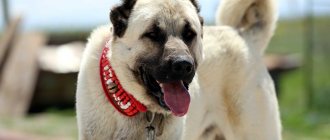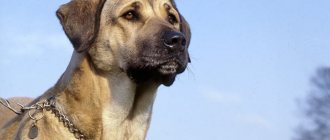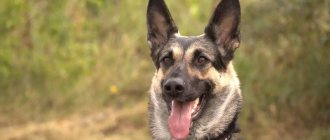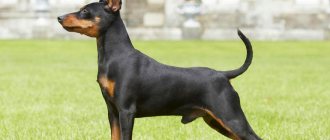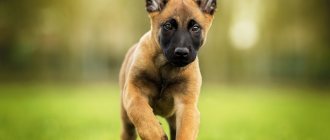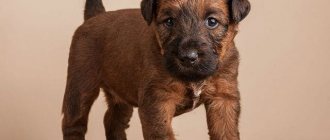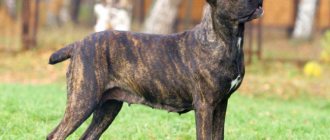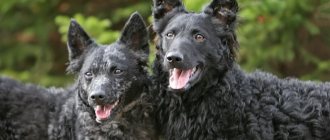The Turkish or Anatolian Shepherd is a strong, confident and calm dog with a wise and insightful gaze. Under her protection, you can safely leave your home and property or entrust her with the protection of your child. After all, a devoted pet will carry out the owner’s instructions until his last breath and will not flinch in the face of any opponent, even those superior to him in strength.
History of the origin of the breed
The distant ancestors of these dogs are depicted on Assyrian bas-reliefs, and their history goes back more than six thousand years. In Turkey, their historical homeland, powerful and hardy animals have helped shepherds guard their flocks of goats and sheep for centuries.
Although shepherd dogs of this breed are called Anatolian, Turkish experts do not recognize this name, calling the dogs Kangal, which translates as black-headed.
What is noteworthy is that purebred Kangals in Turkey are considered a national treasure, and their export from the country is strictly prohibited. But the taboo does not apply to puppies born from a marriage of purebred Kangals and other breeds, which allowed Europeans to take out several mestizos for further selection work with them.
Kangals were used to guard herds of sheep and goats
The official registration of dogs occurred relatively recently - in 1990, so I consider the Anatolian Shepherd breed to be young, despite their centuries-old history. In the same year, the first club of Turkish Shepherd lovers was founded, but so far the animals cannot boast of worldwide fame and popularity among dog lovers.
Historical reference
The Anatolian Shepherd is the oldest dog in Asia Minor. Her ancestors lived here during the Babylonian kingdom. At that time, Kangals were used to hunt lions and selection was carefully carried out, crossing only the strongest and largest individuals.
The name "kangal" goes back to the name of the ancient Turkish city.
Then the dog began to help the shepherds, but was never a shepherd in itself. She did not drive the herds, but protected them from wild animals or the greed of others. She could cope with a wolf alone, and, when catching up with him, she was able to develop very high speed. It is still used as a sentry in Turkey.
Kangal has always been a guard, not a shepherd
The breed received FCI recognition only in 1989. This was influenced by both its comparative small number and limited breeding (allowed only in Turkey).
The dog was named Karabash because of the dark color of its muzzle and ears.
Another name for the breed - Karabash - translated means “black head”, which accurately describes the peculiarity of the color of this dog.
Appearance and description of the breed
Anatolian Shepherds are large and powerful dogs that carry themselves with dignity and self-confidence. And, despite their size and apparent heaviness, the animals are very dexterous and fast and have a well-developed reaction.
Appearance:
- The animals have a proportional build, with a straight back and a wide chest. The height of adult males reaches seventy-five to eighty centimeters, and weight ranges from fifty to sixty kilograms. Females are more graceful and slightly smaller than males. The body length of females does not exceed seventy centimeters, they weigh from forty to fifty-five kilograms;
- the legs are long, straight and muscular;
- the tail is medium length, flexible and fluffy;
- Dogs have a large, wide head with a convex forehead, which smoothly transitions into the nasal part. The eyes are almond-shaped, chocolate or amber-golden in color. Animals have hanging ears of medium length, triangular in shape;
- The Anatolian's coat is straight and short with a thick, dense undercoat. The fur on the neck and chest is longer and fluffier than on the rest of the body;
- The breed standard allows almost any color of Anatolian Shepherds. Dogs may have cream, blue-gray, reddish or light brown fur. The main condition is that the nasal area, cheeks, eyebrows and ears must be painted in a dark shade.
The breed was officially registered in 1990
Character
The Anatolian Shepherd is born to be independent and strong, responsible for protecting the herd without human help or control. These traits make it difficult to keep; owners need to engage in training and socialization so that the dog grows obedient.
They are smart and learn quickly, but are independent and can ignore commands.
According to the stories of Turkish breeders, the Anatolian Shepherd is capable of resisting a pack of wolves and killing a couple of them. These dogs love space and movement, since in their homeland they travel long distances with the herd, patrolling the perimeter.
They are absolutely not suitable for living in cramped apartments, although they get along well with other animals and love children. It’s just that these are guards who were born for space, freedom and real work.
Crowding and lack of exercise will make them bored, which will result in problems for the owner.
They become sexually mature at 18-30 months of age, and puppies and adult dogs have little interest in playing or chasing a stick, instead preferring to run and sometimes swim.
Character and behavioral characteristics
The calm and serene appearance of the Anatolian Shepherd is deceiving. It may seem that the dog is lying calmly near the porch of the house, showing absolutely no interest in passing people and passing cars, but this is a skillful disguise.
In fact, the animal carefully examines its surroundings and never loses its vigilance. And as soon as someone approaches the property under the dog’s control, the pet reacts with lightning speed to a potential threat. Not a single stranger will be able to penetrate unnoticed into the territory patrolled by a shepherd dog, therefore, as a guard, she has no equal.
The protective instincts in these animals are inherent in nature and, upon first getting into the house, the Anatolian Shepherd puppy will waste no time exploring the area entrusted to it. After examining the territory, the pet will become acquainted with all family members and other pets, becoming their personal patron and protector, the protection of which he considers his main purpose.
These dogs are distinguished by their boundless devotion and loyalty to their owners, but always remain balanced and cold-blooded. They do not show strong emotions, and you should not expect that the pet, when meeting its owner, will begin to show joy with barking and wagging its tail.
Kangals get along only with small pets, in which they do not see competition.
Turkish Shepherds are distrustful and wary of strangers. The dog will carefully examine each visitor to make sure that the stranger does not pose a threat to the owner or her possessions. In the presence of an animal, guests should behave carefully and carefully, because a sudden movement can provoke the dog to attack, and even the owner’s order will not prevent it from rushing at the troublemaker. Anatolians do not tolerate the touch of strangers, so it is worth warning guests that petting the dog is prohibited, otherwise the consequences could be disastrous.
As for other pets, shepherds will get along with cats or small dogs, perceiving them as members of their “herd” that need to be protected. But the Anatolian will not get along with dogs of large breeds, for example, a German Shepherd or a St. Bernard, because in their eyes they are rivals for leadership and territory. It is worth noting that dogs do not show aggression or malice towards their own relatives, and will get along well in the same house.
Important: Anatolian Shepherds love to climb to high places in order to survey the surroundings from there and take in the entire territory that belongs to them.
Kangal content
The ideal conditions for keeping a kangal are a large courtyard of a country house. The Anatolian Shepherd should spend most of its time outdoors; any room will be too small for it to move. In addition, boredom can cause a dog's behavior to become destructive. This breed just needs to work.
If you look at this issue from a human perspective, you should take into account that Kangals shed for a very long time and a lot. This can be a real problem when keeping a pet in the house.
In the yard, the kangal should be provided with shelter from bad weather, but keeping it in an enclosure, much less on a leash, is not recommended. The dog must be able to move freely throughout the entire territory in order to keep everything that happens under control.
Interaction with children
Anatolian Shepherds are patient with children, but you should not expect the dog to become a fun play partner for your child. After all, even at an early age, this breed is not prone to games and pranks like other puppies.
For Kangal, a child is an object of protection
For an Anatolian, a child is an object of protection and the baby can be safely left under the supervision of such a vigilant protector. The dog will not let anyone near the child and will not let him out of the protected area.
The best nicknames for Kangal
Kangals fully deserve proud and beautiful names. Therefore, the choice of nickname should be approached with the utmost seriousness. There is no need to call your pet funny names that degrade its dignity. The name should be as majestic as the breed itself. You can pay attention to Turkic names. So, Kangal boys can be called:
- Adalat - justice;
- Agalak - power;
- Batyr - hero;
- Demir - iron;
- Kamal - fortress;
- Sultan is a ruler.
Suitable names for Kangal girls:
- Akhtar - comet;
- Gaya - rock;
- Danara - talisman;
- Jita - song;
- Oisha - lunar;
- Uni is a spring.
Teaching methods and training
When deciding to get an Anatolian Shepherd, the owner should prepare for the fact that it will take a lot of time and effort to raise and train the animal. These dogs are not distinguished by their obedient and flexible character and must be taught to obey from an early age. If you do not raise the puppy properly, the pet will become uncontrollable and will make its own decisions, ignoring the orders of the owner.
Patience, calmness and perseverance are the necessary qualities in raising an Anatolian puppy
Dogs of this breed are smart and quick-witted and have excellent memory, thanks to which they quickly remember commands, but this does not mean that they will obey orders unquestioningly. After all, the Anatolian will carefully analyze each command of the owner, and if he considers it meaningless, then no circumstances will force the animal to carry out the instructions.
To teach a dog obedience, the owner must make it clear that he is the leader and authority. Once you show weakness and allow your pet to do as he pleases, it will no longer be possible to achieve obedience from him. Therefore, it is necessary to repeat each command until the animal completes it.
It is also worth considering the innate hostility of Anatolian Shepherds towards strangers and other animals. And it will depend only on the owner how the pet will behave in the presence of guests. After all, a dog that is not accustomed to discipline may refuse to allow people into its territory, even if they came accompanied by the owner. And along with the basic commands - “sit” and “come to me”, it is very important to teach your pet to obey orders - “place” and “no”. Otherwise, the pet itself will decide who is worthy of entering the house, and the owner will only have to come to terms with the choice of the animal.
Training and education
Kangal is an obedient dog, especially since the purpose of its life is to serve man. Therefore, training this breed gives good results. But given the independent nature and independence of the Karabash. Education should begin as early as possible and try to avoid mistakes.
The puppy must undergo socialization. He must be among people all the time and communicate with them, but he needs only one owner. This person will not only work with the pet, but also feed it.
The owner himself must train Kangals in order to establish mutual understanding with his pet.
When training, the method of positive motivation is used. Of course, at first, treats act in this capacity, but then praise and affection will be enough. Kangal wants to serve a person so much that he will strive to complete any task in order to receive another portion of tenderness from his master.
When raising a Kangal, it is very important to maintain balance. The owner must be attentive, caring, affectionate, but at the same time firm. Let the Kangal walk in front of you once, and you will remain on the sidelines in his worldview for a long time.
Physical punishment when raising an Anatolian Shepherd is unacceptable. An embittered Kangal may decide to stand up for himself, which will end very unfavorably for the person.
Care and maintenance
Caring for the unpretentious and undemanding Anatolian Shepherd will not require much effort from the owner.
Anatolians are unpretentious in grooming, but require long walks
Hygiene procedures:
- there is no need to brush the dog regularly, and such a procedure is only needed during the period of intense molting of animals, which occurs in spring and autumn;
- The pet also does not need frequent bathing, so water treatments for the pet are arranged no more than two or three times a year;
- the eyes and inner surface of the ears are periodically cleaned of secretions and accumulated dirt;
- Plaque can form on the teeth of animals, so the dog’s teeth are regularly examined and, if necessary, cleaned with a special brush.
Conditions of detention:
- Anatolian Shepherds feel comfortable outdoors at any time of the year. But a comfortable and spacious enclosure should be equipped for your pet, where he can rest and take shelter during severe frosts;
- the dog needs long, frequent walks and physical activity;
- it is necessary to devote enough time to communicate with your pet and to educational disciplinary activities.
Important: these animals do not tolerate restrictions of freedom, so putting them on a chain is extremely undesirable, otherwise the dog will become nervous, irritable and aggressive.
Theses
- It is critical that the Anatolian Shepherd is well trained and understands what is a threat and what is not. Untrained dogs can be aggressive and uncontrollable.
- Anatolian Shepherds are independent and require less human approval than other breeds. They will not wait for orders, and will begin to act themselves if the situation requires it.
- The territory they protect must be surrounded by a fence.
- Some Anatolian Shepherds are excellent diggers.
- While guarding territory, they may bark. Especially at night.
- Some can be aggressive towards other dogs.
- They shed profusely, especially in spring.
- They can test a person's strength, since they are the dominant breed. Owners need to be prepared to assert their authority gently and persistently.
- Due to their size, Anatolian Shepherds are expensive to own. Consider the costs of feeding, treatment, education.
Health and Lifespan of the Anatolian Shepherd Dog
This breed is distinguished by its endurance and excellent health. Dogs calmly tolerate temperature changes, adapt to changes in environment without stress, and are not afraid of intense physical activity.
The nose area, cheeks, brow ridges and ears should be painted in a dark shade.
In general, these are healthy animals with strong immunity that are not susceptible to hereditary diseases.
But like other large dog breeds, Anatolians are prone to hip dysplasia, so calcium should be added to their food.
Older animals often develop tumors, especially at the site of injury, and the owner should more closely monitor the health of an aging pet.
On average, Anatolians live between ten and twelve years.
Important: dogs of this breed are very sensitive to anesthesia and may not tolerate surgery performed under general anesthesia.
How to choose a puppy
It is very difficult to purchase a kangal, given the ban by the Turkish authorities on the export of purebred individuals. But this only increases interest in dogs of this breed. From private breeders, a puppy can cost at least 30 thousand rubles, but no one will guarantee the purebred of the baby. Of course, you can distinguish them by their specific color, but even a specialist will not be able to evaluate the rest of the characteristics of a dog at a young age.
Even Kangal puppies are not afraid of harsh weather conditions
There are also nurseries, rarely single-breed (for example, Antalkaya), more often breeding similar breeds, for example, Alabais. Here a puppy can cost from 65 thousand rubles, and the most promising babies can cost 120 thousand rubles.
Diet and feeding regime
The Anatolian Shepherd cannot be called picky when choosing food. These animals happily eat any food offered by the owner.
If dry food is chosen as food, then you should give preference to premium food, which contains vitamins, beneficial additives and microelements.
When choosing natural food, you must remember that the main daily dish should be porridge with pieces of boiled or raw meat. You can diversify the menu with fermented milk products, vegetables, offal and sea fish.
Anatolian Shepherds eat immoderately, as a result of which they are prone to overweight and obesity. To avoid this, you should establish a feeding regime, giving the dog food twice a day, at strictly prescribed times and observing the dosage of portions.
It is forbidden to feed your pets sweets, smoked meats, fish and chicken bones and fatty salty foods.
History of the breed
Kangal is one of the most ancient breeds. It was these huge, loyal, powerful dogs that were among the first to serve faithfully to man, protecting homes, livestock and the lives of family members from wild animals and intruders.
The formation of the breed took place over thousands of years. At first, nature itself left only the strongest Kangals alive.
Later, when the owners began to seriously engage in breeding work, breeding Kangal Karabash on their property, a serious selection began.
The largest, most powerful, fearless dogs were used as sires. Breeders primarily paid attention to growth and watchdog abilities.
There is no exact information about the origin of the Kangal Shepherd. According to one of the most plausible versions, the ancestors of modern Kangals are considered to be hunting mastiff dogs that lived in Mesopotamia.
As long as the Turkish Kangal exists, it serves people. You can’t call him a shepherd dog; he won’t constantly run and herd sheep or cows.
His responsibilities include protecting livestock from predators and thieves. Usually the karabash settles down on some hill and monitors the herd and the surrounding area.
Noticing a threat, the dog will first try to scare and drive away the enemy; if he does not retreat, the Kangal will use his teeth. Even a lion and a bear cannot resist the strength of several Anatolian Shepherds.
There is a legend about the Turkish Kangal: “The Crown Prince of India presented as an expensive gift to the Ottoman padishah an unusually powerful, huge, fearless dog, which emerged victorious in a fight with a lion.
The new owner took the dog with him on a hike. The pet got lost on Kangal territory.” It is believed that it was his offspring, obtained as a result of crossing with local herding shepherd dogs, that became the ancestors of the Turkish Kangals.
The Turkish government closely monitors and controls the export of kangal çoban köpeği to other countries. It is not surprising that the largest population of representatives of the breed is observed in Turkey, in Asia Minor.
In their homeland, Kangal Shepherd Dogs are used to guard flocks of sheep.
In Kenya and Namibia - to protect livestock from cheetahs and lions.
In America they are used as bodyguards and guard dogs.
The cost of a puppy of this breed
Purebred Kangals are considered the property of Turkey and are prohibited from being exported from the country
. Not many kennels are engaged in breeding Anatolian Shepherds, so their cost is quite high. For a purebred puppy with a pedigree and documents, the future owner will have to pay from thirty to sixty thousand rubles.
But babies with defects (non-standard color, white spots on the body, long hair) are much cheaper. And if the owner does not plan for his pet to participate in exhibitions and simply wants to purchase a guard for his home, then he can buy a puppy for ten to twenty thousand rubles.
How to buy a Turkish Kangal puppy
In our country, this dog is rare; to buy a purebred Kangal puppy, you need to find a specialized nursery. There are few of them, most are located in Moscow and the Moscow region. That’s why they are expensive – 40-80 thousand rubles. It is important to pay attention to the living conditions of the animals, documents from the parents, and certificates from the veterinarian. All animals must be vaccinated.
Anatolian Shepherd puppies are sold at 2-2.5 months. At this age, the main breed characteristics appear: body type, color, bite, paw and tail placement. The puppy must be healthy and moderately active. He should not show cowardice or aggression.
The photo shows what the puppies look like:
The video complements the characteristics of Turkish Kangals:
Video: Anatolian Shepherd Dog (Karabash). Breed characteristics, care
Video: Kangal - the strongest dog in the world
Video: Kangal - review of the most “survival” dog)))
The Kangal dog is not for apartment living. This is a vigilant and brave guard, a large, hardy dog. He is efficient, hardy, and always ready to protect his owner. But without proper upbringing it can become dangerous.
Owner reviews
How do owners of Anatolian Shepherds characterize their pets?
Veronica: a great dog for home protection
.
The most valuable qualities of this dog are intelligence, endurance and devotion. Yes, she is not as obedient as other breeds, but she is a reliable and loyal pet. Our dog is brave and determined and I never worry that thieves will break into the house if I have to be away for a long time.
Evgeniy: this is a calm and intelligent pet.
We were given an Anatolian Shepherd puppy as a gift, and I immediately started looking for information about her. Honestly, I didn’t like the fact that the dog’s character was independent and stubborn, but as it turned out, this doesn’t apply to our Emir. He is smart, intelligent and balanced, and even made friends with our daughter’s favorite Yorkshire terrier and condescendingly watches as the baby runs around barking loudly throughout the house and area.
The Anatolian Shepherd is not a working dog with a playful and cheerful disposition and is unlikely to be a fun play companion. But over the centuries, she has regularly coped with the role of watchman and protector and is always ready to stand guard over peace and protect the lives of those to whom she is faithful and devoted with all her heart and soul.
Breed traits
Breed traits (on a 5-point scale)
| Anatolian Shepherd (Turkish Kangal, Anatolian Karabash) | |||
| Activity | in the house | 2 | |
| on the street | 4 | ||
| Obedience | training | 2 | |
| strangers | 4 | ||
| Domination | in family | 4 | |
| over dogs | 4 | ||
| Defending your territory | from people | 2 | |
| from dogs | 3 | ||
| Sociability | in family | 5 | |
| with strangers | 2 | ||
| with dogs | 3 | ||
| Concentration | in family | 2 | |
| in front of strangers | 4 | ||
| with dogs | 3 | ||
| Aggressiveness | in family | 3 | |
| to strangers | 5 | ||
| to the dogs | 3 | ||
| to cats | 2 | ||
| Family behavior | calmness | 2 | |
| demand for affection | 3 | ||
| excitability | 4 | ||
| playfulness | 4 | ||
| excessive barking | 1 | ||
| behavioral breakdowns | 1 | ||
| Tolerance for children | up to 4 years | 3 | |
| over 4 years old | 3 | ||
| Institutional use | watchman | 5 | |
| bodyguard | 5 | ||
This breed is often compared to the following dog breeds: German Shepherd, Caucasian Shepherd, Australian Shepherd (Aussie), Akita Inu, Cane Corso.
The photo shows what Anatolian Shepherds look like:
Breed standard
The Turkish Kangal dog breed is quite large. The body of the animal is proportionally built, the limbs are moderately long. Despite their impressive size, Anatolian Shepherds are agile, hardy, and run well and quickly.
European Kangals are slightly different from purebred Turkish ones. The official description of the breed in the standard combines several related species.
Characteristics of the Anatolian Shepherd:
- the head is wide. The muzzle is blunt, tapering slightly towards the nose. Its length is slightly less than the length of the skull. The lips are slightly drooping, black at the edges;
- jaws – strong, scissor bite;
- nose - black lobe. The exception is animals of the liver color. Theirs is brown;
- eyes – medium-sized, almond-shaped, proportional, widely set. The color varies from yellowish to brown, corresponding to the color of the coat. The look is calm, thoughtful;
- ears – hanging, triangular, with rounded edges. In a calm state, touch the cheekbones;
- the body is powerful, rectangular, the muscles are well developed. The neck is strong, and males develop a dewlap. The chest is deep, the stomach is tucked. The loin protrudes slightly above the general line of the back;
- tail – set high, standard length. When the dog is calm, it hangs down. In an excited state, it rises onto its back and wraps itself in a ring;
- paws are strong, with prominent muscles and flexible joints. The pads are covered with thick skin, allowing shepherds to move painlessly on any surface. The claws are black and short.
The Anatolian Karabash has a dense coat, short or semi-long. The undercoat is thick and resembles felt. It protects dogs from heat and cold. The fur on the neck, shoulders and hips is slightly longer. Curly or wavy guard hairs are not acceptable.
The standard allows any color options for Kangals. However, most often you can see a photo of a dog with a black mask on a beige, piebald or red face.
The Anatolian Shepherd gives the impression of being a strong animal. Her movements are smooth and careful. When running, dogs keep their head, neck and back at the same level, which makes their gait more insinuating.
Disqualifying defects of Kangals:
- excessive aggression or cowardice;
- malocclusion;
- muzzle too short;
- coat without undercoat, short, smooth.
The officially valid standard was published on October 31, 2016. According to the FCI classification, the Anatolian Karabash belongs to group 2: “Pinchers and Schnauzers – Molossians and Swiss Mountain Cattle Dogs.”
History of the Turkish breed
The Kangal is the only Turkish dog breed that has been recognized throughout the world. It is revered as a national treasure and represented as a symbol in the former Ottoman Empire. The export of these dogs is controlled by the state.
Kangal gained worldwide fame in the 80s of the last century, when it was first exported to the USA, and from there it spread to Western European countries.
In Turkey the breed is highly prized as a herding guard dog , they are said to be descended from northern dogs, as evidenced by their curved tail and short coat.
In terms of working qualities, this dog has no equal; the Kangal was often used to protect the herd from wolves and other predatory animals. In Russia and European countries, the dog plays the role of a guard.
Feeding
The nutrition of any dog should be complete and balanced. The diet must include natural meat, meat by-products, cereals, cereals and vegetables, with the exception of rice and potatoes, these products should be excluded. You should also not give confectionery and rich products.
Natural food can be replaced with dry food, but only if you prefer premium and super-premium food.
Please note that you must choose only one type of food ; you cannot combine natural food with dry food, otherwise this may negatively affect the dog’s health.
The breed is prone to overeating and obesity , so it is important to feed the dog at certain hours; the daily food intake should be approximately 20% of the Kangal's weight. For more detailed information on feeding the Anatolian breed, we recommend that you contact specialized pet stores or veterinary clinics.
